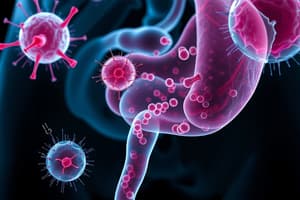Podcast
Questions and Answers
What is a primary cause of Clostridium difficile-associated colitis?
What is a primary cause of Clostridium difficile-associated colitis?
- Transient bacterial overgrowth
- Antibiotic exposure (correct)
- Viral infection
- High fiber diet
Which investigation is most appropriate if colorectal cancer is suspected?
Which investigation is most appropriate if colorectal cancer is suspected?
- Upper GI endoscopy
- MR enterography
- Stool calprotectin test
- Colonoscopy with biopsies (correct)
What dietary approach is recommended for managing Irritable Bowel Syndrome (IBS)?
What dietary approach is recommended for managing Irritable Bowel Syndrome (IBS)?
- High protein diet
- High fiber diet
- Low FODMAP diet (correct)
- Gluten-free diet
Which of the following is a possible severe complication of a C. difficile infection?
Which of the following is a possible severe complication of a C. difficile infection?
For suspected Coeliac disease, which procedure is indicated for diagnosis?
For suspected Coeliac disease, which procedure is indicated for diagnosis?
What is the primary mechanism that leads to secretory diarrhoea?
What is the primary mechanism that leads to secretory diarrhoea?
Which condition is commonly associated with osmotic diarrhoea?
Which condition is commonly associated with osmotic diarrhoea?
What characterizes inflammatory diarrhoea?
What characterizes inflammatory diarrhoea?
Which of the following best describes altered motility as a cause of diarrhoea?
Which of the following best describes altered motility as a cause of diarrhoea?
What is a common symptom of Crohn’s disease?
What is a common symptom of Crohn’s disease?
Which mechanism underlies antibiotic-related diarrhoea caused by Clostridium difficile?
Which mechanism underlies antibiotic-related diarrhoea caused by Clostridium difficile?
What is a characteristic symptom of coeliac disease?
What is a characteristic symptom of coeliac disease?
What is the main feature of secretory diarrhoea caused by viral infections like Rotavirus?
What is the main feature of secretory diarrhoea caused by viral infections like Rotavirus?
Flashcards are hidden until you start studying
Study Notes
Diarrhoea Mechanisms
- Secretory diarrhoea: Excessive fluid secretion into the intestines, exceeding absorption.
- Causes: Infections, laxatives, polyps.
- Osmotic diarrhoea: Non-absorbable substances in the intestines draw water in, causing excess fluid.
- Causes: Sugar substitutes, lactose intolerance.
- Inflammatory diarrhoea: Inflammation in the intestines releases proteins, blood, mucus, and fluids into the stool.
- Causes: Ulcerative colitis, Crohn's disease, tuberculosis, cancers.
- Altered motility diarrhoea: Changes in intestinal motility disrupt absorption and digestion.
- Slow motility: Bacterial overgrowth and malabsorption.
- Fast motility: Reduced contact time for absorption.
- Causes: Irritable bowel syndrome (IBS), diabetes mellitus (neuropathy), hyperthyroidism.
Intestinal Diseases with Diarrhoea
- Ulcerative colitis: Continuous mucosal inflammation starting in the rectum and extending upwards.
- Symptoms: Bloody diarrhoea, urgency, abdominal pain.
- Crohn's disease: Transmural inflammation affecting any part of the gastrointestinal tract, with patchy "skip lesions".
- Symptoms: Diarrhoea (sometimes bloody), abdominal pain, weight loss, fistula formation.
- Coeliac disease: Autoimmune response triggered by gluten ingestion, leading to villous atrophy and malabsorption in the small intestine.
- Symptoms: Diarrhoea, steatorrhoea (fatty stool), weight loss.
- Infectious diarrhoea: Bacterial infections (Salmonella, Shigella, Campylobacter) and viral infections (Rotavirus, Norovirus) can disrupt the intestinal lining and cause diarrhoea.
- Small intestinal bacterial overgrowth (SIBO): Excessive bacterial growth in the small intestine can lead to malabsorption and osmotic diarrhoea.
Antibiotic-Related Diarrhoea
- Clostridium difficile (C. diff) associated colitis: Overgrowth of pathogenic C. diff bacteria following antibiotic exposure.
- Mechanism: Toxin production and infection.
- Mild, non-specific osmotic diarrhoea: Transient loss of bacteria that normally absorb short-chain fatty acids.
- Impact:
- Mild diarrhoea: Discomfort, dehydration, and electrolyte imbalances.
- Severe C. difficile infection: Toxic megacolon, perforation, sepsis, increased mortality (especially in older patients and those with comorbidities).
Management of Chronic Diarrhoea
- Investigations:
- Blood tests: CRP, FBE, iron studies, coeliac serology, TSH.
- Stool analysis: Calprotectin, C difficile toxin, microscopy for ova, cysts, parasites.
- Suspected colorectal cancer or IBD:
- Colonoscopy and ileoscopy with biopsies.
- Suspected coeliac disease:
- Upper gastrointestinal endoscopy with biopsy.
- Suspected small bowel IBD:
- Magnetic resonance enterography or capsule endoscopy.
- Management:
- IBS: Dietary modifications (low FODMAP), psychological support, tricyclic antidepressants (TCA).
- Coeliac disease: Dietician, gastroenterologist, gluten avoidance.
- IBD: Gastroenterologist for treatment.
Studying That Suits You
Use AI to generate personalized quizzes and flashcards to suit your learning preferences.




